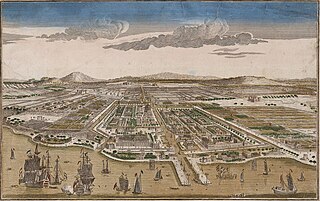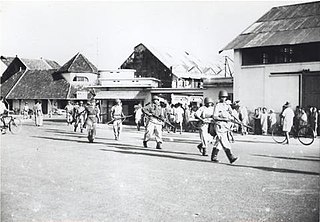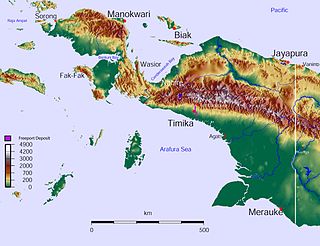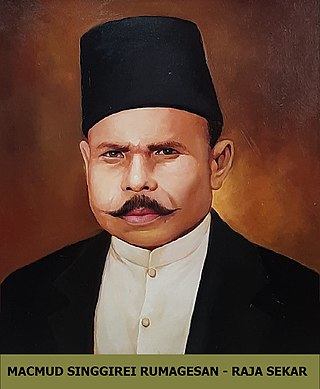See also
Other statues constructed by Edhi Sunarso in the 1960s:
| West Irian Liberation Monument | |
|---|---|
| Native name Monumen Pembebasan Irian Barat | |
| Location | Sawah Besar, Jakarta, Indonesia |
| Coordinates | 6°10′13″S106°50′06″E / 6.170298°S 106.834925°E |
| Built | 1963 |
| Architect | |
| Sculptor | Edhi Sunarso |
West Irian Liberation Monument (Indonesian : Monumen Pembebasan Irian Barat) is a postwar modernist monument located in Jakarta, Indonesia. It is located in the center of Lapangan Banteng (formerly Waterloo Square) in Sawah Besar, Central Jakarta. Sukarno, then President of Indonesia, commissioned the monument in 1963 following the West New Guinea dispute in which Indonesia received the territory of Western New Guinea from the Netherlands.
The West Irian Liberation Monument is located in the center of Lapangan Banteng, facing west towards the St. Ursula Catholic School across the road from the park. The park itself was formerly known as the Waterlooplein, a parade ground of the colonial administration. [1]
On top of the monument, visible as a 36-meter high pedestal, stands a bronze, [2] bare chested wild-haired man breaking free from his shackles with his arms and legs widely spread, the former facing towards the sky. [3] The face holds a loud, screaming expression, symbolizing rebellion and independence. [4]
In the late 1950s and early 1960s, the Netherlands still possessed the western part of New Guinea, which it had agreed to discuss a year after the Round Table Conference. Following failed negotiations and the incorporation of the region into Netherlands, Sukarno decided to adopt a more forceful stance, later escalating into military operations such as Operation Trikora. [5] After the New York Agreement in 1962, the Netherlands agreed to hand over the territory to Indonesia.
The statue was officially commemorated on 17 August 1963, at the 18th independence day of the country and a year after it began construction. As of today, the monument is under the responsibility of Jakarta's parks services. [2]
The statue of the West Irian Liberation Monument has been commissioned earlier in 1962 before the actual annexation of West Irian into Indonesia. On Independence Day, 17 August 1962, a pro-integration rally was held in front of the palace and Johannes Abraham Dimara wore chains which was severed in front of the crowds at Lapangan Banteng, Jakarta. Sukarno was inspired by the moment, and commissioned a statue of the liberation of West Irian. [6] The design of the monument was based on a sketch by the artist Henk Ngantung who was also the deputy governor of Jakarta from 1964 to 1965. The design of the monument shows a muscular man, shouting, with arms outstretched breaking free of the chains of colonialism. [7] The bronze statue is about 11 metres (36 ft) tall from feet to the tip of its outstretched fingers. The statue stands over a 20 metres (66 ft) tall pedestal in postwar modernist style. The 36 metres (118 ft) high tugu (statue and pedestal) was erected at the center of Lapangan Banteng.
The bronze statue was sculpted by Team Pematung Keluarga Area Yogyakarta (Yogyakarta Area Family of Sculptors Team) which was led by Edhi Sunarso. Edhi Sunarso also executed the Selamat Datang Monument and the Dirgantara Monument in Jakarta. [8] [9] Friedrich Silaban acted as the architect for the project. [10] [1] [2]
The location of the West Irian Liberation Monument was supposed to be the first monument seen by people visiting Jakarta through the Kemayoran Airport. [11]
Other statues constructed by Edhi Sunarso in the 1960s:
Kemusuk is a hamlet (dukuh) in the Argomulyo village, Sedayu subdistrict, Bantul Regency, Special Region of Yogyakarta, Indonesia. The area, around 10 km to the west of Yogyakarta towards the town of Wates, is known as the birthplace of former president Suharto.

Jakarta is Indonesia's capital and largest city. Located on an estuary of the Ciliwung River, on the northwestern part of Java, the area has long sustained human settlement. Historical evidence from Jakarta dates back to the 4th century CE, when it was a Hindu settlement and port. The city has been sequentially claimed by the Indianized kingdom of Tarumanegara, the Hindu Kingdom of Sunda, the Muslim Sultanate of Banten, and by Dutch, Japanese and Indonesian administrations. The Dutch East Indies built up the area before it was taken during World War II by the Empire of Japan and finally became independent as part of Indonesia.

Merdeka Square is a large square located in the center of Jakarta, Indonesia. Merdeka is the Indonesian word for freedom or independence. Measuring approximately one square kilometer in area, if the surrounding fields within the Merdeka Square are included, it is considered one of the largest squares in the world. At 75 hectares, it is over five times the size of Tiananmen Square, and 12 times the size of Place de la Concorde.

The Makassar Uprising, also known as Andi Aziz rebellion, was a skirmish in Makassar, Sulawesi, between former Royal Dutch East Indies Army soldiers under Captain Andi Aziz and the Republic of the United States of Indonesia government. The purpose of the uprising was to revolt against the incorporation of the Indonesian federated "states" into the Indonesian Republic. However, the uprising was quashed in a little over two weeks when troops under Lieutenant Colonel Suharto and Colonel Alexander Evert Kawilarang arrived at Makassar to find only light resistance.

The capital of the Republic of Indonesia is Jakarta, one of the oldest continuously inhabited cities in Southeast Asia. Previously known as Batavia, it was the de facto capital of the Dutch East Indies. In the early 20th century, the Dutch East Indies government attempted to relocate the capital from Batavia to Bandung. During Indonesia's struggle for independence, the Indonesian government moved the capital to Yogyakarta and then to Bukittinggi, where it remained for a short time until the restoration of control to Jakarta. In 2019, during his annual state of the union address at the parliament, President Joko Widodo announced a plan to relocate the capital to Kalimantan on the island of Borneo. As part of the plan, part of Kutai Kartanegara Regency and Penajam North Paser Regency in East Kalimantan will be carved out to create a new province-level planned city, and the capital will be relocated to a more central location within Indonesia. On 17 January 2022, the name was revealed to be Nusantara. Although Jakarta is no longer a capital since 17 August 2024, it is expected that the province will join with Banten or West Java as a city.

Selamat Datang Monument, also known as the Monumen Bundaran HI or Monumen Bunderan HI, is a monument located in Central Jakarta, Indonesia. Completed in 1962 by sculptor Edhi Sunarso, the Selamat Datang Monument is one of the historic landmarks of Jakarta.

The Heroes Monument, popularly known as Tugu Tani is a bronze statue and important landmark located in Jakarta, Indonesia. The monument celebrates the heroes of the struggles of the Indonesian nation symbolized by a peasant youth wearing a caping with a rifle on his shoulder, a mother behind him offering him a dish of rice. The caping is a traditional farmer's hat in Indonesia, thus the statue is also referred as the Farmer's Monument.

Operation Trikora was an combined Soviet-Indonesian military operation which aimed to seize and annex the Dutch overseas territory of Netherlands New Guinea in 1961 and 1962. After negotiations, the Netherlands signed the New York Agreement with Indonesia on 15 August 1962, relinquishing control of Western New Guinea to the United Nations.

Jalan M.H. Thamrin or Jalan Thamrin is a major thoroughfare in Jakarta, Indonesia. The road is located at the center of Jakarta, running from the north end of Jalan Jenderal Sudirman at West Flood Canal at the south end to the roundabout near Arjuna Wijaya Statue Jakarta at the north end. Developed in the 1950s, the road was a landmark of post-colonial Indonesia and continues to have a prominent importance in Jakarta.

Major TNI Johannes Abraham Dimara was an Indonesian National Hero from Papua.

The West New Guinea dispute (1950–1962), also known as the West Irian dispute, was a diplomatic and political conflict between the Netherlands and Indonesia over the territory of Dutch New Guinea. While the Netherlands had ceded sovereignty over most of the Dutch East Indies to Indonesia on 27 December 1949 following an independence struggle, it retained control over its colony on the western half of New Guinea. The Indonesian government claimed this territory as well, on the basis that it had belonged to the Dutch East Indies and that the new Republic of Indonesia was the legitimate successor to the former Dutch colony.
Lapangan Banteng is a historic square located in a historic area formerly known as Weltevreden, today Sawah Besar subdistrict, Central Jakarta, Indonesia.
Edhi Sunarso, born Sunarso, was an Indonesian sculptor and public artist known for numerous well-known monuments and landmarks found throughout Jakarta, including the Selamat Datang Monument and Dirgantara statue, also called the Pancoran Monument, in Pancoran, South Jakarta. He taught sculpture at Yogyakarta State University and the Indonesian Institute of the Arts, Yogyakarta.
The Golden Triangle of Jakarta or can also be referred to as Medan Merdeka–Thamrin–Sudirman Axis or Sudirman–Thamrin–Kuningan Axis, is a roughly triangular area in the center of Jakarta, Indonesia, extending from Central Jakarta to South Jakarta. Most of the city's foreign embassies and tallest skyscrapers are located in the area, which is the main CBD of Jakarta.

Taman Proklamasi is a park complex located in Central Jakarta, Indonesia. The park is located at the former property of Sukarno at what was known as the house at Jalan Pegangsaan Timur 56. The house, now demolished, is where the Proclamation of Indonesian Independence was first read by Sukarno.
Dirgantara Monument, also known as Gatot Kaca Monument after the Javanese wayang figure, is a monument located in Jakarta, Indonesia. It is also known as Tugu Pancoran, after tugu a word for statue and pedestal, and the South Jakarta subdistrict of Pancoran, where it is located. The monument was commissioned by President Sukarno in 1964 as a tribute to the Indonesian Air Force and early Indonesian aviators who flew against the Dutch to achieve independence.

Hotel Borobudur is a five star hotel and serviced apartment located in Central Jakarta, Indonesia. Conceived in the 1960s by President Sukarno, it was meant to be the second international-standard hotel to be built in the newly independent country. The hotel is located near Lapangan Banteng, which during the colonial times was the center of what was the military-European colonial neighborhood of Weltevreden. At its opening in 1974, as the Hotel Borobudur Inter-Continental, it was the largest hotel in Jakarta.

Machmud Singgirei Rumagesan was a king of Sekar and pro-integration activist from West Papua. He founded the movement Gerakan Tjendrawasih Revolusioner Irian Barat (GTRIB) in 1953, and became the member of Supreme Advisory Council in 1959. On 10 November 2020, Singgirei Rumagesan was posthumously declared a National Hero of Indonesia for his lifelong efforts to unite West Irian with Indonesia.

Colonel Dahlan Djambek was a military officer, independence fighter, and minister in the Cabinet of the Revolutionary Government of the Republic of Indonesia (PRRI). During the Japanese occupation of West Sumatra, he was appointed Chairman of the Sumatra Chokai.
Kustiyah (1935–2012) was an Indonesian artist.